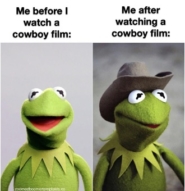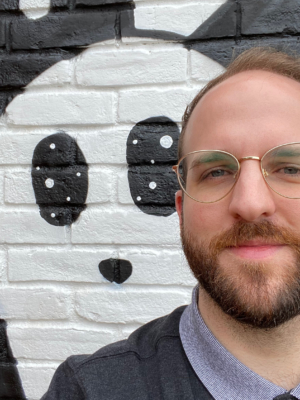A Resounding Yeehaw for Cowboy Kermit
I have a running list of favorite memes that live rent-free in my mind. There’s the blinking white guy, the international symbol for disbelief. There’s the beloved Arthur character DW holding the fence, standing in for all of us standing on the outside of some cultural moment. There’s Spongebob Squarepants (who has a meme for every occasion) voicing his need to exit an uncomfortable situation.
But among the many memes—and there are many—that I keep on standby, at the very top of the list is Kermit the Frog wearing a cowboy hat. Perhaps not as famous as tea-sipping Kermit, Cowboy Kermit started making his rounds on the Internet sometime last year, perhaps after Muppet History Twitter first brought renewed attention to his existence. The images are, in a word, delightful. There’s the Muppet magic that makes Kermit look like he’s standing on his own in cowboy boots. There’s the portrait that looks like it was taken with a professional quality background in a photo studio.
Kermit appears to stand alone. Of course, we know this is an illusion. As one image reveals, Kermit is in a classic Western standoff with eight men. And although the Internet memes don’t include this aspect, it’s the most important piece: he’s also there with his friends.
* * *
 As a meme, people don’t need familiarity with the source material to enjoy themselves. Memes function as shorthand, a unit of language that translates an entire experience into a single still or gif. Cowboy Kermit serves to communicate the feeling of being peripheral to yeehaw culture while participating in some aspect of it, be that watching Western films, wearing cowboy-adjacent fashion, or listening to country music. It can be applied to listening to Kacey Musgraves as a country-crossover-pop star or wanting clothing from Beyoncé’s Rodeo collection. It’s a lighthearted way to acknowledge you don’t quite see yourself as a cowboy, but if you were one, Kermit would be an accurate representation.
As a meme, people don’t need familiarity with the source material to enjoy themselves. Memes function as shorthand, a unit of language that translates an entire experience into a single still or gif. Cowboy Kermit serves to communicate the feeling of being peripheral to yeehaw culture while participating in some aspect of it, be that watching Western films, wearing cowboy-adjacent fashion, or listening to country music. It can be applied to listening to Kacey Musgraves as a country-crossover-pop star or wanting clothing from Beyoncé’s Rodeo collection. It’s a lighthearted way to acknowledge you don’t quite see yourself as a cowboy, but if you were one, Kermit would be an accurate representation.
I’ve spent my entire life in Texas, but I have never felt drawn to the masculine stereotypes of the cowboy image. Growing up, people called me “sensitive” because I was in touch with my emotions in a way that other boys worked to hide. Because of this, I was bullied by boys in the sixth grade. I learned early on that I was never going to identify with so-called “manliness.” For one, I wasn’t athletic, despite my efforts. Beyond that, I didn’t want to be like boys who treated others like they did me.
As a kid, I didn’t idolize heartless, solitary men swinging their guns and doling out revenge. The John Waynes or Clint Eastwoods. But I did idolize Kermit. I watched the various iterations of The Muppet Show and all of the movies. I couldn’t articulate this at the time, but Kermit was an alternative to the images of masculinity available to me. He was the hero of his stories, not because of any display of strength or individual bravado, but because of his heart and his desire for companionship. But I hadn’t thought of him in this way before, at least not explicitly.
As the Muppet History Twitter notes, Cowboy Kermit was a product of The Muppet Movie, the original 1979 film. It’s been years since I last saw it, but I recognize the famous frog touting a cowboy hat. When images of Cowboy Kermit started circulating the web, I laughed at how deeply it resonated with me. I had to see the movie again.
In a scene near the end of the movie, Kermit is standing up to an evil corporation that sells frog legs and wants him to represent them in advertisements. Throughout the movie, Kermit has been meeting the other Muppets and bringing them along on his journey to Hollywood. In the midst of his showdown with Doc Hopper’s French Fried Frog Legs, Kermit relates the following:
“I have a dream. A dream about singing and dancing and making people happy. That’s the kind of dream that gets better the more people you share it with. And, well, I found a whole bunch of friends who have the same dream, and that kind of makes us like a family.”
As Kermit delivers his speech, the camera pans slowly to reveal that Kermit is no longer standing alone. All of the Muppets he met along the way are now behind him. As much as I love the meme of Cowboy Kermit, it belies a deeper truth about the narrative: Kermit isn’t a rugged individualist in the tradition of Wayne or Eastwood, but a new model—offered all the way back in 1979—of a cowboy who stands apart by rallying together.
Ben Lewellyn-Taylor lives in Dallas, TX. He is an MFA student at Antioch University, where he works on the Lunch Ticket staff. Ben co-hosts Book Cult, a virtual indie book club, with Cristina Rodriguez. His work can be found at benlewellyntaylor.com.





